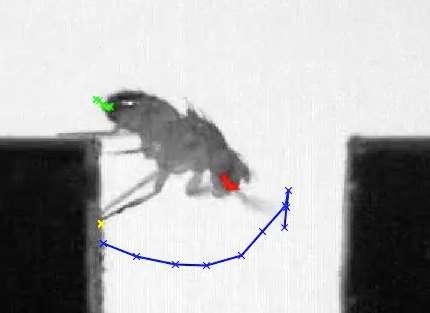Mutation in transient receptor potential channel impairs fine motor control but leaves gross motor proficiency intact

In all animals—from humans to fruit flies—coordinated physical movement relies on two regimes of motor control: gross and fine. In humans, gross motor control enables large movements of the body and limbs, such as during walking, running or throwing; fine motor control is necessary for more precise movements—pressing a specific key while playing a musical instrument, for example.
In fruit flies (Drosophila melanogaster), rhythmic walking depends largely on gross motor proficiency, while fine motor skills are essential for accomplishing more difficult tasks, such traversing large gaps in the terrain, which requires highly orchestrated and precise movements of multiple appendages, all at the same time.
In a new study that focuses on locomotion in the fruit fly—a relatively simple animal that exhibits many of the same behaviors as humans and other mammals—UC Santa Barbara's Craig Montell and his research team have identified a transient receptor potential (TRP) channel that plays a key role in the insect's fine motor coordination. Their research is published in the journal Nature Communications.
Most significant, according to Montell, UCSB's Duggan professor of neuroscience, the team has demonstrated that null mutations in the TRPy (gamma) channel specifically impair highly coordinated movements while leaving gross motor control intact. As described by Montell this, 'breakthrough in understanding fine motor control in animals such as the fruit fly might shed light on the molecular processes that underlie fine motor control in other animals, including humans.'
During the past few years, members of the TRP superfamily have emerged as key molecular channels that participate in a variety of senses. For example, one TRP channel is expressed in taste buds and allows mammals to taste sweet and bitter ingredients, while others function in light sensation or in sensing stimuli that cause itching and changes in temperature.
'There's a TRP channel in mammals, including humans, that not only senses hot temperatures but is also turned on by the pungent ingredient in hot chili peppers called capsaicin,' said Montell, a faculty member in UCSB's Department of Molecular, Cellular and Developmental Biology (MCDB) and the paper's senior author. 'That's why you feel hot when you're eating spicy food. You're activating the same TRP channels that are activated by hot temperatures.'
The current study, however, focuses on a less recognized sense—proprioception, sometimes referred to as the 'sixth sense.' Proprioception gives your brain information on how your body is positioned in space. 'Animals must have a sense of the position of their body parts to survive,' said Montell. 'You have to know where your body parts are—whether they're static or moving, whether they're straight or at angles.'
Added Bradley Akitake, a postdoctoral fellow in the Montell lab and the paper's lead author, 'The mechanically activated TRP channel that we characterized is critical for this task.
'We already know from previous research that there are some mutations disrupting TRP channels that cause these animals to be absolutely spastic,' he continued. 'These mutant flies display profound and obvious defects in motor control. We detected a problem in TRPy mutant flies only after increasing the difficulty of the locomotion tasks.'
To separate fine and gross motor behaviors, the researchers shot high-speed video of their wing-clipped fruit fly subjects—both wild type and TRPγ mutants—completing two locomotor tasks: walking and gap crossing. 'Walking across a catwalk is an easy task for a fruit fly, whereas gap crossing, having to fully stretch out your body while keeping your rear feet planted and not fall into the water, is much more challenging,' said Akitake. 'We can adjust the difficulty by changing the size of the gap.'
When looking at how well the fruit flies maneuvered small, less challenging gaps, the researchers found little difference in the success rates of the wild type and TRPγ gamma mutants. Gross motor proficiency was normal in both. However, upon increasing the gap to 3.5 millimeters, just over 1.5 times the body length of the fly, the wild type had an approximately 60 percent success rate, whereas only a small percentage of TRPγ mutant animals crossed successfully. 'By slowing down the video and measuring in detail the body angles and leg reach of the flies, we found that TRPγ mutants were not making the fine posture changes necessary to successfully cross large gaps,' said Montell.
So what does the discovery of a role for the TRPγ channel in fruit fly proprioception mean for other animals, including humans? Additional research is necessary, but according to Montell, diseases that specifically target the human nervous system—amyotrophic lateral sclerosis, multiple sclerosis and Parkinson's disease, for example—devastate motor ability in affected individuals. 'In order to restore motor function,' he said, 'we need to first understand the sensory systems that contribute to fully coordinated movements.'

















